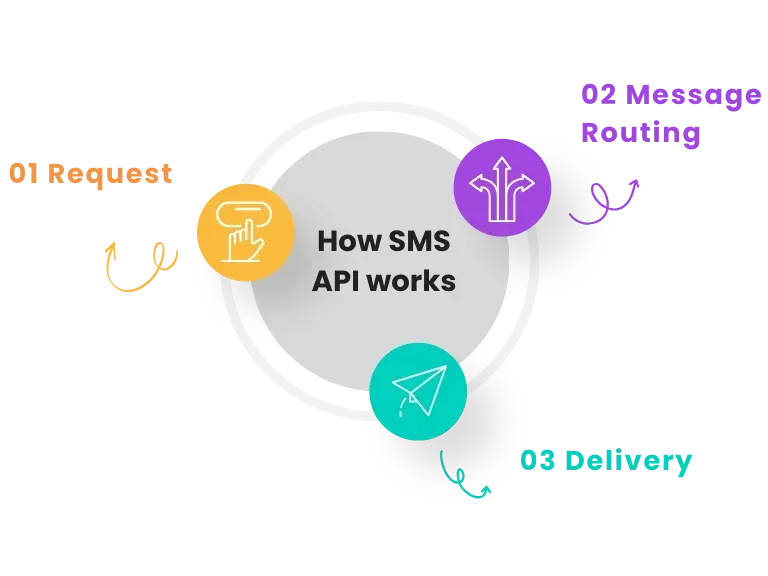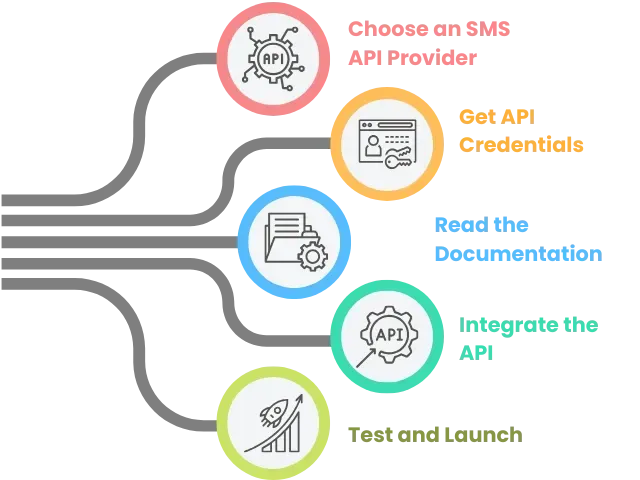How SMS API Works: The Ultimate Guide for 2025
An SMS API is a powerful tool that streamlines communication, automates processes, and scales your business’s messaging efforts.
Shivam Singh
•In today’s fast-paced digital environment, communication is key. Businesses are always looking for ways to enhance customer engagement, automate processes, and improve operational efficiency. SMS API is becoming a cornerstone in business communication strategies because of their ease of integration and powerful capabilities. In this guide, we’ll explain how SMS API works, why it’s crucial for modern businesses, and how you can implement it to streamline your communication processes.
What is an SMS API?

An SMS API (Application Programming Interface) allows applications to send and receive text messages through an SMS gateway, providing direct communication between your software and mobile networks. By integrating an SMS API, businesses can automate text messaging without manually accessing a web interface or mobile device.
Why SMS APIs Matter:
SMS APIs eliminate manual processes, ensuring 24/7 communication. This is crucial for sending important notifications, transaction alerts, and appointment reminders that need to reach customers anytime. Unlike email, SMS enjoys a much higher open rate—around 98%—making it an ideal channel for time-sensitive messages.
How Does an SMS API Work?

To understand how an SMS API works, you need to grasp its core function—connecting the web to telecom networks.
Let’s break it down step-by-step:
Request
When you send a message via an SMS API, your system generates a request containing the message, recipient’s phone number, and any necessary authentication details (e.g., API key, tokens). This request is sent to an SMS gateway.
Message Routing
The SMS gateway, which acts as a bridge between the internet and mobile networks, receives the request. It identifies the destination (recipient’s network) and forwards the message via the mobile operator’s network.
Delivery
The mobile operator delivers the SMS to the recipient’s mobile device. The API can then return a delivery status, indicating whether the message was successfully delivered or if there were any errors, such as an unreachable phone number. This entire process happens in seconds, making it possible to send bulk messages to thousands of users simultaneously, without any delays.
Types of SMS APIs:
HTTP-based SMS APIs: Most common, using simple web requests to send messages. REST APIs: More advanced, allowing for flexible integration with modern web applications. SMPP (Short Message Peer-to-Peer Protocol): A robust option typically used by telecom providers for large-scale, real-time messaging.
Advantages of Using an SMS API
There are several reasons why businesses prefer SMS APIs over manual text messaging or web-based SMS platforms:
Automation and Efficiency
SMS APIs allow for automated messaging, freeing up time for staff. You can schedule and trigger messages based on events, such as order confirmations or subscription renewals.
Scalability
Whether you’re sending a single message or thousands, an SMS API can handle it effortlessly. This is especially useful for businesses needing to engage customers in bulk—whether for marketing campaigns, service notifications, or alerts.
Real-time Delivery and Analytics
An SMS API enables real-time tracking of message delivery. This ensures accountability and allows businesses to measure the effectiveness of their campaigns through data like delivery rates and response times.
Customization and Personalization
With an SMS API, messages can be dynamically generated to include personalized content such as names, purchase details, or location-specific information, boosting engagement. Looking for more information on SMS APIs? Get in touch with our experts.
Use Cases for SMS APIs
Businesses across various industries use SMS APIs to streamline communication. Here are some of the most common use cases:
Notifications and Alerts
Financial institutions use SMS APIs to send real-time transaction alerts, while e-commerce platforms notify customers about order confirmations and shipping updates.
Marketing and Promotions
Retail businesses leverage SMS APIs to send personalized offers and discounts. Campaigns can be segmented to ensure the right message reaches the right audience at the right time.
Two-Factor Authentication (2FA)
To enhance security, many platforms use SMS APIs for sending one-time passwords (OTPs), ensuring secure logins and transactions.
Appointment Reminders
Healthcare providers and service-based businesses use SMS APIs to remind customers of upcoming appointments, reducing no-show rates.
Customer Feedback and Surveys
Automate the collection of customer feedback by sending SMS surveys after key interactions, such as support calls or purchases.
Internal Communications
Some companies use SMS APIs to send urgent notifications or updates to employees, ensuring swift communication during emergencies or critical situations. Get a free strategic consultation session with our experts.
How to Get Started with SMS API

Integrating an SMS API is easier than ever. Most SMS API providers offer extensive documentation and libraries to help developers integrate the API quickly. Here’s a quick checklist to get started:
Choose an SMS API Provider
Select a reliable SMS gateway provider that offers a robust API service with features tailored to your business needs. Consider factors like delivery speed, uptime, and support.
Get API Credentials
Sign up for an account with your chosen provider and retrieve your API key and authentication tokens.
Read the Documentation
Thoroughly read the API documentation, which will explain the endpoints, authentication methods, and error handling.
Integrate the API
Use the provider’s code snippets and developer tools to integrate the API into your existing systems. This process typically involves writing a few lines of code, depending on the complexity of your use case.
Test and Launch
Once the API is integrated, test it to ensure it’s working properly. This can include sending test messages, checking delivery reports, and reviewing error logs. When everything is functioning as expected, launch your system live.
Security and Compliance Considerations

While SMS APIs are powerful, businesses must adhere to strict regulations, such as TCPA (Telephone Consumer Protection Act) in the US or GDPR (General Data Protection Regulation) in Europe. Ensure that customers have opted-in to receive SMS messages and always provide a way for them to opt-out. Additionally, some industries, like finance and healthcare, have specific data privacy laws that govern how you can store and transmit sensitive information via SMS.
Conclusion
An SMS API is a powerful tool that streamlines communication, automates processes, and scales your business’s messaging efforts. Whether you’re looking to enhance customer experience, boost marketing campaigns, or improve security with two-factor authentication, SMS APIs can help you achieve your goals with minimal manual effort. By integrating an SMS API, you’re not just sending messages; you’re opening the door to faster, more efficient, and reliable communication that elevates your business to the next level.
Key Takeaways:
- SMS APIs allow your applications to send and receive SMS messages without human intervention.
- They improve scalability, automation, and efficiency in business communication.
- From OTPs to marketing promotions, the use cases are vast and valuable for any industry.
- Always ensure compliance with legal regulations to protect your business and customers.
Related Article : What is SMS Gateway? How does it work? Why it is Essential for Your Business